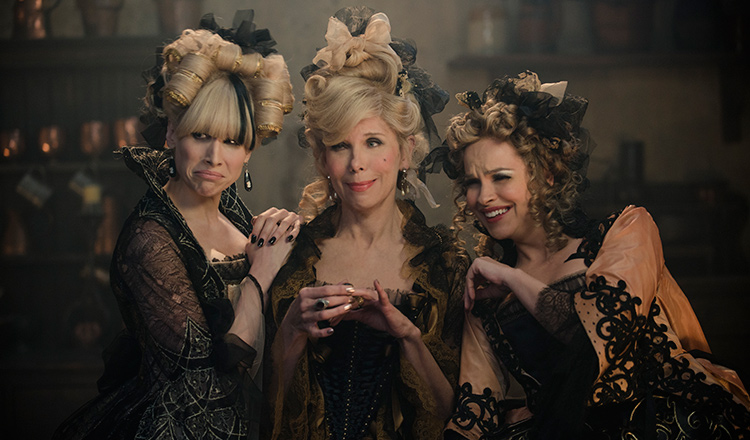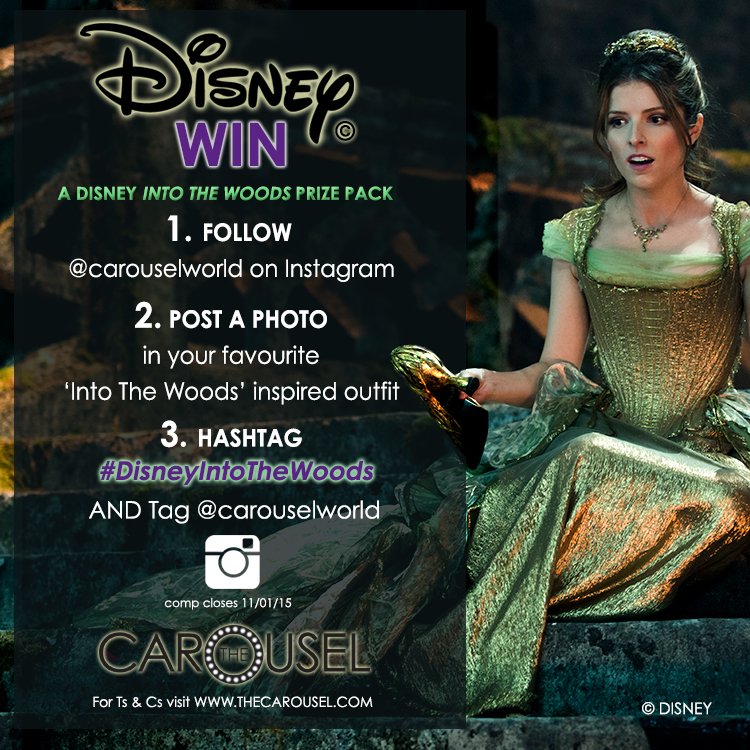There’s nothing quite like a Broadway musical, with the theatre’s history, the talent who have performed on those stages, and the atmosphere and New York, New York big city lights. Or is there?
The Broadway hit Into the Woods ran for a mega 764 performances and won a string of awards, including a Tony® Awards for Best Score (Stephen Sondheim), Best Book of a Musical (James Lapine), Best Actress in a Musical (Joanna Gleason as the Baker’s Wife), and a GRAMMY® Award for Best Original Cast Recording, among other awards. The original’s composer and lyricist Stephen Sondheim, along with Tony® winner James Lapine, who wrote both the stage and screenplay, left quite an impression of theatre goes forever after, with the stage musical going on to be produced around the world, including a 1988 U.S. national tour, a 1990 West End production and London revivals. So it was always going to be a challenge to translate this mega musical to the big screen. But how do the two compare? Here’s your answers…
- The Big Screen Version Has A Modern Twist On Traditional Fairy tales
You’ll still find your beloved Brothers Grimm fairy tales in a musical format, with the story following the classic tales of Cinderella, Little Red Riding Hood, Jack and the Beanstalk and Rapunzel, all tied together by an original story involving a baker and his wife and their wish to begin a family, sabotaged by the witch who put a curse on them. But this has a modern message. Rapunzel’s story resonates with typical teenagers, seeking freedom from her parents, the baker and his wife long for a child, and Cinderella just wants to find her Prince. It’s what happens ‘after’ they get their wishes, and the consequences of their actions, that makes this fairy tale contemporary. Film Director Rob Marshall says he and his co-producer were thrilled Disney took on this modern day spin. “We were thrilled that the company embraced the project the way that they did,” explains Rob. “They were truly interested in expanding the definition on of what a ‘modern fairy tale’ film could be.”
- The Film Has Less Characters, But They’re More Developed
Film Director Rob Marshall says that while he tried to retain as much as possible from the stage production, some things from the original didn’t translate to film. “Everything worked so beautifully that we didn’t want to change anything if we didn’t have to,” explains Rob. “However, I believe the biggest disservice you can do when translating a stage musical to film is to not think of it as a film first. If you are too faithful to the original, it can end up simply not working as a film. So we were meticulous in considering every change. We eliminated a couple characters, because we already had so many with so many story lines and we wanted to keep things as streamlined as possible.”
- The Film Still Retains The Integrity & Substance Of the Original
James Lapine was the award-winning author of the stage play, and the screenplay, so it is no surprise that the best bits are ever-present in the film. Director Rob Marshall says, “It was wonderful to work with James because I had admired his work for years. I felt it was important to work with the original creators of the piece in order to retain the integrity and substance of the work, while of course reimagining it as a film. I was so impressed with how open James was to trying new things, and how he instinctively understood that what works on stage would not necessarily translate to film. He really approached this as a new piece. For example, Cinderella’s ‘On the Steps of the Palace,’ was originally written as a presentational song where the character speaks directly to the audience, explaining what has just happened to her. Obviously, that can’t be done on film, so we reconceived the song so that everything happens in the actual moment when Cinderella gets stuck in the tar on the steps. She has a split second to make a decision, so we froze the action so that it all takes place within that second and the song becomes an internal monologue. And then [composer] Stephen Sondheim brilliantly adjusted the lyrics so that it all takes place in the present.”
- There Are No Scene Breaks
No surprises here! But of course it’s a whole different ball game telling a story in one movie stream to breaking stories between acts and with stage sets. Film director Rob Marshall says the secret to the film musical was ensuring that it looked seamless to the audience. “We didn’t want the scene to stop before the song begins, and a lot of that has to do with how the camera moves. Our cinematographer, Dion Beebe, understands that deeply. He is a painter with light and motion. And Colleen Atwood is a magnificent designer, she was able to create different worlds and looks for each of the different characters, yet still have them come together and create a unified vision. Dennis Gassner, our production designer, has an extraordinary eye and knew how to put things together so beautifully and integrate these different worlds, especially the two worlds of real woods and our stage woods. And our editor, Wyatt Smith, is an extraordinary man because he knows music so well and knows how to cut musically, and it’s very important that you don’t see the editing: it should feel fluid as if it is all one piece.”
- The Film’s Giant Slaying Scene Is Even More Exciting
Stage and screen play writer James Lapine said he and stage and screen composer Stephen Sondheim worked very closely with film director Rob Marshall to support the storytelling, but some things naturally translated better on screen. “Rob has done a brilliant job of bringing the musical to film and making it a real movie experience and not just a staged musical that’s being filmed,” explains James. “I really enjoyed the opportunity to write it with him and realise the vision for the material that excited him. I think if you write something that’s really strong, it can stand up to all kinds of interpretations, and having the film made was a wonderful opportunity to see it translated into another medium. Killing the Giant on stage was a difficult thing to theatricalize, in terms of the limited capabilities of stagecraft, but with the film we were able to reinvent how the Giant is killed and show it in an entirely different manner, which made it much more cinematic and exciting. In the stage version we had a narrator who was the voice of the storyteller, and we’ve taken that away in the film and created a different narrative. The Woods have a wonderful, visual sense and Rob and his design team have done an amazing job. Scale-wise, you get a wonderful sense of these people getting lost in a vast environment, and again, this is something that can’t really be expressed on stage, but is beautifully realised on screen.”
- The Film Ending Is Different…
It’s OK, we’re not going to spoil it for you. But if you have seen the play, you’ll be in for a surprise! “For the end of the film, [film director] Rob took a different approach, and has done a beautiful job of capsulizing what we were trying to do on the stage,” explains stage and screen play writer James Lapine. “Rob made the right choices in deciding where we want to take the time to have someone sing and where we just want to move the action along. And he of course used the camera to tell the story when and where words were not necessary.”
- The Film Is Same-Same, But Surprisingly Different
Stage and screen play writer James Lapine is the first to admit he’s a great admirer of film director Rob Marshall’s work, but he knew it was a given Rob would add his own special touch to the story. “He has a unique visual sense, and all his films are extraordinarily gorgeous and rich and lush, and that’s so appropriate for this project,” explains James. “Rob knew the material inside and out, and wanted to add his own vision to the material while respecting the author’s intent. I think he did a beautiful job of walking that fine line. Thousands and thousands of people have seen productions of Into the Woods. It’s very popular in schools, so you have to be somewhat careful that you don’t completely reinterpret it, because people are expecting the story they know. On the other hand, you want a film version of Into the Woods that they’ve never seen before. Rob was so wise in understanding that and having an extraordinary passion to do the project and to respect its message, without getting bogged down in all the details of the stage version. Into the Woods is a story that needs to move. It’s a quest musical. The characters are going after something that they’re passionate to get to, and you have to keep the tension and the suspense and the drive intact. And I think, as a choreographer, that’s something that he really understands – how to put together short takes, short scenes and moments that drive to other moments that all add up to a surprising end.”
WIN!
The Carousel, together with Into The Woods, are running a fantastic competition, where you can WIN a Disney Into The Woods prize pack!
Simply upload a photo of yourself on Instagram using the #DisneyIntoTheWoods hashtag, showing an outfit inspired by your favourite Into the Woods fairy tale and tag @carouselworld. You could be wearing your fave red coat, a la Little Red Riding Hood, a fantastic pair of Cinderella-esque shoes, wearing a Rapunzel style ‘do, wearing your cool dungarees Jack style, or chillin’ with your dashing Prince. Let your imagination go wild!










